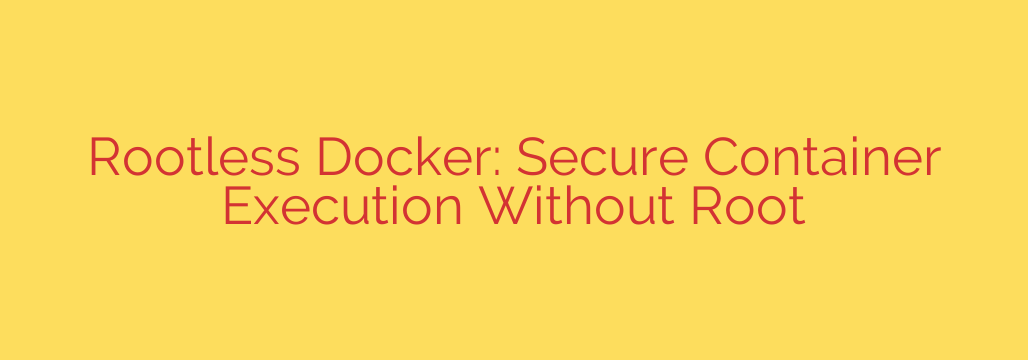
Rootless Docker: A Practical Guide to Hardening Your Container Security
For years, developers and system administrators have relied on Docker to build, ship, and run applications. It’s a powerful tool, but its standard configuration comes with a significant security caveat: the Docker daemon traditionally requires root privileges to operate. This creates a potential attack vector where a container escape vulnerability could lead to a full-system compromise.
Fortunately, there is a more secure way to manage your containers. Rootless Docker allows the entire Docker environment, including the daemon and containers, to run under the authority of an unprivileged user. This fundamentally changes the security posture of containerized workflows, making it an essential tool for any security-conscious team.
The Inherent Security Risk of the Default Docker Setup
In a standard Docker installation, the daemon runs as the root user. This is necessary for it to perform low-level system operations like managing network interfaces, manipulating filesystems, and interacting with the kernel. However, this power is also a liability.
If an attacker finds a vulnerability in the Docker daemon or manages to “escape” a container’s boundaries, they could potentially gain the same root-level privileges on the host machine. A successful container escape in a rootful Docker environment is a critical security incident, granting the attacker complete control over the host.
What is Rootless Docker? A Safer Approach to Containerization
Rootless mode addresses this core problem by removing the need for root privileges. It achieves this by leveraging a powerful Linux kernel feature called user namespaces (userns).
Here’s the core concept:
- The Docker daemon itself is started and managed by a regular, non-root user.
- Inside the container, processes can still believe they are running as
root(with user ID 0). - However, thanks to user namespaces, this internal
rootuser is mapped to an unprivileged user ID on the host system.
In essence, the root user inside the container is a complete fabrication from the host’s perspective. If an attacker compromises a container and gains “root” access within it, they are still just a low-privilege user on the actual host machine. Their ability to cause damage is drastically limited, as they cannot access sensitive system files or interact with hardware.
The Key Security Benefits of Running Docker Without Root
Adopting Rootless Docker provides immediate and tangible security improvements that align with modern best practices.
Drastically Mitigates Container Escape Vulnerabilities: This is the primary advantage. Even if a critical vulnerability allows an attacker to break out of the container, they will only have the permissions of the unprivileged user running the Docker daemon. They cannot escalate privileges to take over the host.
Enforces the Principle of Least Privilege: This fundamental security concept dictates that a process should only have the permissions it absolutely needs to perform its function. By running Docker as a non-root user, you are adhering to this principle and minimizing your system’s attack surface.
Protects the Host System Integrity: With Rootless Docker, containerized processes are isolated from the host’s core system files and configurations. The risk of a rogue container overwriting critical binaries or modifying system settings is virtually eliminated.
Understanding the Limitations and Trade-offs
While Rootless Docker is a massive leap forward for security, it’s important to understand that it comes with a few limitations compared to the traditional rootful mode.
- Networking Constraints: By default, rootless containers cannot bind to privileged ports (any port below 1024). This is a system-level restriction for all non-root users. Additionally, the default networking stack (
slirp4netns) may have slightly lower performance than the standard networking used in rootful mode. - Limited Resource Management: Interacting with cgroups for fine-grained resource control (CPU, memory limits) can be more complex without root privileges.
- Certain Features Are Unavailable: Some advanced Docker features that require deep kernel interaction, such as adding certain kernel capabilities or mounting specific host devices, may not be supported.
- Storage Driver Selection: Not all storage drivers are compatible.
overlay2is supported, but the fallbackvfsdriver can be significantly slower.
For the vast majority of application workloads, these trade-offs are a small price to pay for the immense security gains.
Actionable Security Tip: How to Get Started
Implementing Rootless Docker is more straightforward than ever. Most modern Linux distributions provide the necessary prerequisites, such as the uidmap package.
The recommended method is to use the official installation scripts provided by Docker, which handle the user namespace configuration for you. Once installed, you can enable the Docker service to run at boot under your specific user account using systemd.
To maximize security, combine Rootless Docker with other best practices:
- Use minimal base images for your containers.
- Scan your images for known vulnerabilities.
- Avoid running processes as
rootinside your containers whenever possible, even in a rootless environment.
By adopting Rootless Docker, you are taking a proactive step to harden your infrastructure. It transforms containerization from a potential liability into a truly sandboxed and secure environment, ensuring that a single container compromise doesn’t become a full-system breach.
Source: https://collabnix.com/rootless-docker-running-containers-securely-without-root-privileges/








